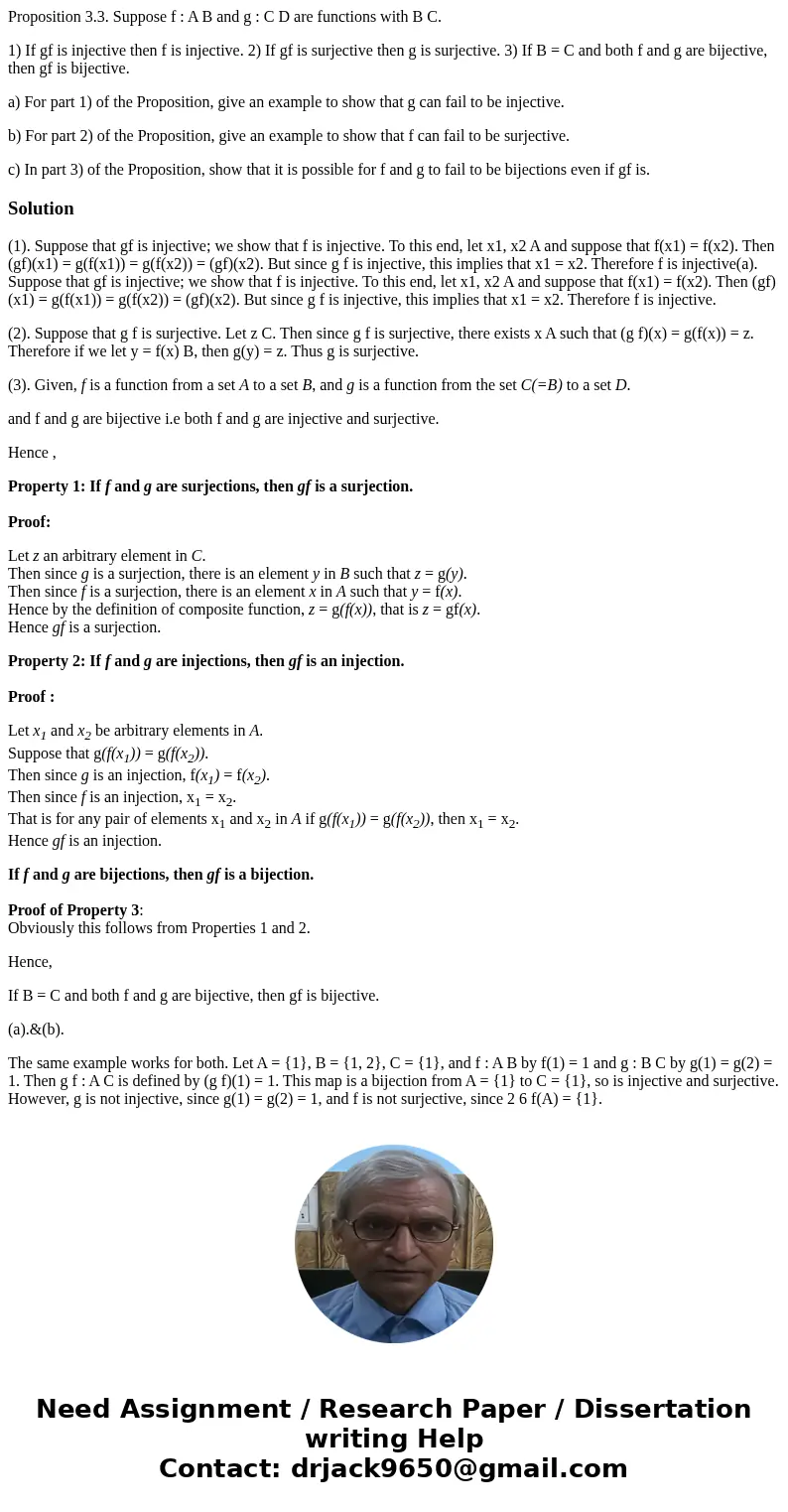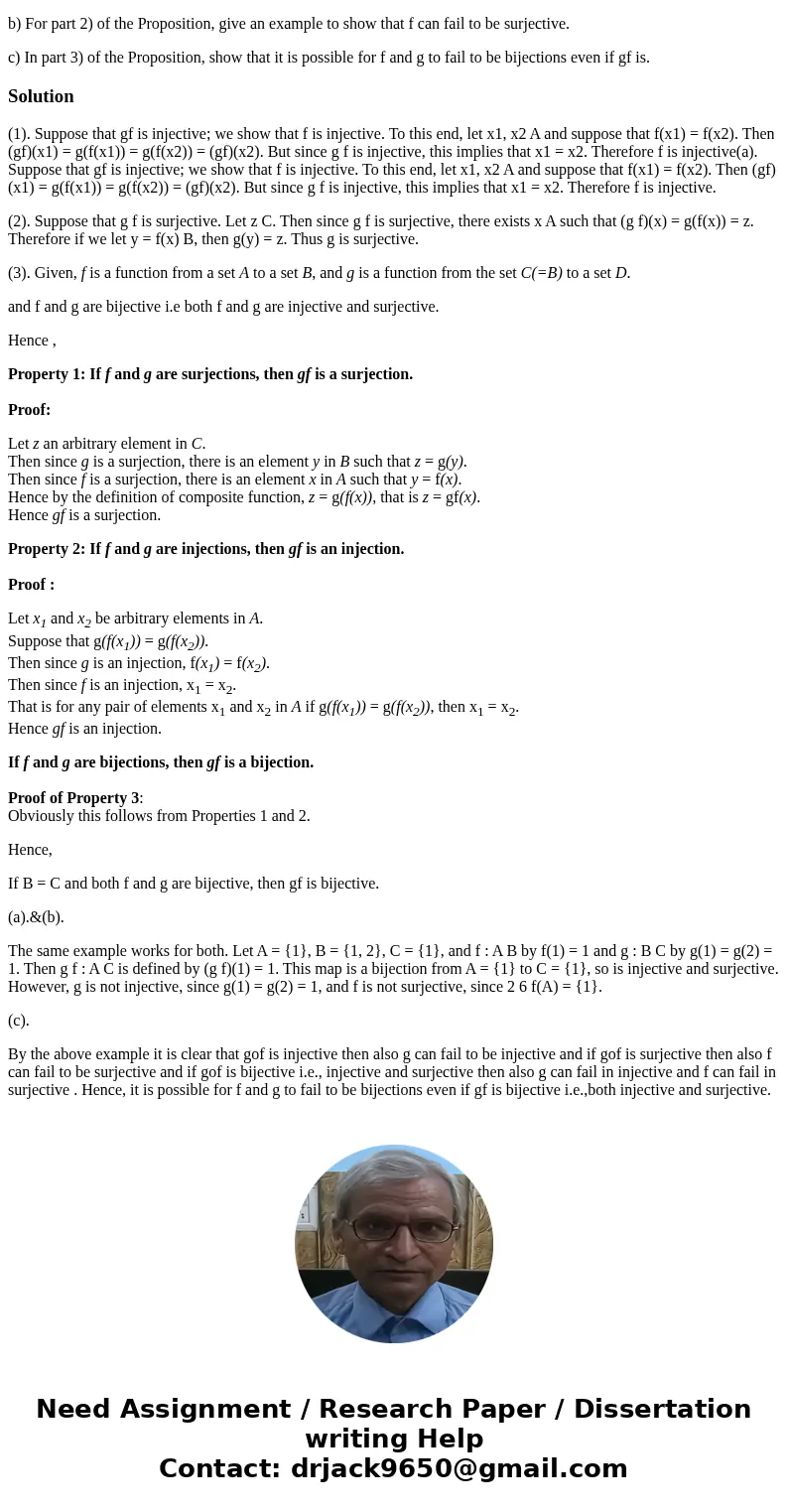Proposition 33 Suppose f A B and g C D are functions with
Proposition 3.3. Suppose f : A B and g : C D are functions with B C.
1) If gf is injective then f is injective. 2) If gf is surjective then g is surjective. 3) If B = C and both f and g are bijective, then gf is bijective.
a) For part 1) of the Proposition, give an example to show that g can fail to be injective.
b) For part 2) of the Proposition, give an example to show that f can fail to be surjective.
c) In part 3) of the Proposition, show that it is possible for f and g to fail to be bijections even if gf is.
Solution
(1). Suppose that gf is injective; we show that f is injective. To this end, let x1, x2 A and suppose that f(x1) = f(x2). Then (gf)(x1) = g(f(x1)) = g(f(x2)) = (gf)(x2). But since g f is injective, this implies that x1 = x2. Therefore f is injective(a). Suppose that gf is injective; we show that f is injective. To this end, let x1, x2 A and suppose that f(x1) = f(x2). Then (gf)(x1) = g(f(x1)) = g(f(x2)) = (gf)(x2). But since g f is injective, this implies that x1 = x2. Therefore f is injective.
(2). Suppose that g f is surjective. Let z C. Then since g f is surjective, there exists x A such that (g f)(x) = g(f(x)) = z. Therefore if we let y = f(x) B, then g(y) = z. Thus g is surjective.
(3). Given, f is a function from a set A to a set B, and g is a function from the set C(=B) to a set D.
and f and g are bijective i.e both f and g are injective and surjective.
Hence ,
Property 1: If f and g are surjections, then gf is a surjection.
Proof:
Let z an arbitrary element in C.
Then since g is a surjection, there is an element y in B such that z = g(y).
Then since f is a surjection, there is an element x in A such that y = f(x).
Hence by the definition of composite function, z = g(f(x)), that is z = gf(x).
Hence gf is a surjection.
Property 2: If f and g are injections, then gf is an injection.
Proof :
Let x1 and x2 be arbitrary elements in A.
Suppose that g(f(x1)) = g(f(x2)).
Then since g is an injection, f(x1) = f(x2).
Then since f is an injection, x1 = x2.
That is for any pair of elements x1 and x2 in A if g(f(x1)) = g(f(x2)), then x1 = x2.
Hence gf is an injection.
If f and g are bijections, then gf is a bijection.
Proof of Property 3:
Obviously this follows from Properties 1 and 2.
Hence,
If B = C and both f and g are bijective, then gf is bijective.
(a).&(b).
The same example works for both. Let A = {1}, B = {1, 2}, C = {1}, and f : A B by f(1) = 1 and g : B C by g(1) = g(2) = 1. Then g f : A C is defined by (g f)(1) = 1. This map is a bijection from A = {1} to C = {1}, so is injective and surjective. However, g is not injective, since g(1) = g(2) = 1, and f is not surjective, since 2 6 f(A) = {1}.
(c).
By the above example it is clear that gof is injective then also g can fail to be injective and if gof is surjective then also f can fail to be surjective and if gof is bijective i.e., injective and surjective then also g can fail in injective and f can fail in surjective . Hence, it is possible for f and g to fail to be bijections even if gf is bijective i.e.,both injective and surjective.


 Homework Sourse
Homework Sourse